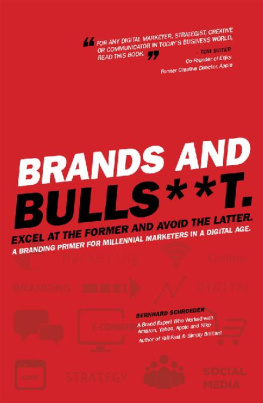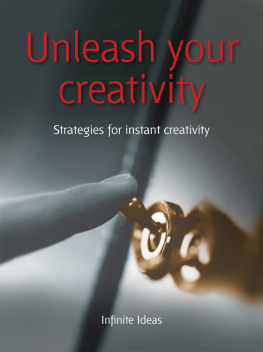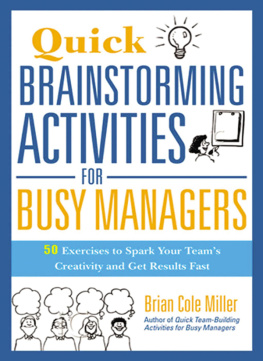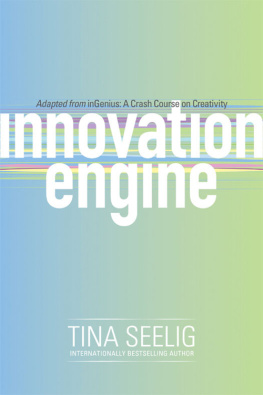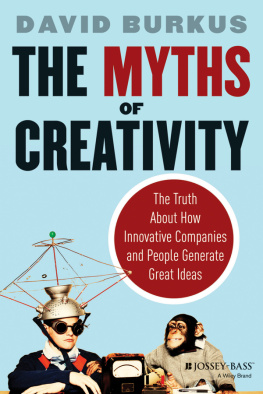Thank you for downloading this
AMACOM eBook.
Sign up for our newsletter, AMACOM BookAlert, and
receive special offers, access to free samples,
and info on the latest new releases from AMACOM,
the book publishing division of
American Management Association.
To sign up, visit our website: www.amacombooks.org

SIMPLY
BRILLIANT
SIMPLY
BRILLIANT
POWERFUL TECHNIQUES
TO UNLOCK YOUR CREATIVITY
AND Spark NEW IDEAS
BERNHARD SCHROEDER

For all the people who were told they were never creative,
this book is for you. Create away.
Heres to the crazy ones, the misfits, the rebels, the troublemakers, the round pegs in the square holes... the ones who see things differentlytheyre not fond of rules.... You can quote them, disagree with them, glorify or vilify them, but the only thing you cant do is ignore them because they change things.... They push the human race forward, and while some may see them as the crazy ones, we see genius, because the ones who are crazy enough to think that they can change the world are the ones who do.
STEVE JOBS
CONTENTS
SIMPLY
BRILLIANT
INTRODUCTION:
WHY CREATIVITY MATTERS IN YOUR
CAREER AND LIFE
The chief marketing officer strode into the conference room and sat at the head of a very large conference tableone large enough for me, two of my colleagues, and forty-five of his fellow employees, all directors or vice presidents of product development or marketing. Seven years earlier, the company had been a startup. Their growth had been so meteoric they were now an $8 billion Fortune 500 company with enough executives just in that room to field a basketball league. Nonetheless, they were in trouble.
All eyes turned to the person at the head of the table as he spoke. As you know, we are under attack from our chief competitor in a very competitive marketplace and we are being engaged in a price war, a place we do not want to be, he said. In response to that attack, we have hired the most creative marketing agency in the world, and these three senior partners will review our situation and then provide us with a creative marketing response. But more important, they will advise us on innovating our current product offerings so that we can be more competitive. All eyes in the room shifted to us. I could only think of three questions. Who outsources their companys creativity and product innovation to an outside firm? What did all these people actually do? How did they get here?
Today, most people still believe that some of us are born creative and others are notand thats just the way it is. However, our creativity is not simply inherited, like brown eyes or blonde hair. Most people also still believe that right-brained people are more creative and left-brained people are more analytical, even though research in the past five years has shown that, in fact, we use both sides of our brain when we are being creative. We use both sides of the brain to fire our creative juices.
Many people associate creativity only with artists, writers, designers, and filmmakers, not programmers, for example, or lawyers, marketers, and accountants. But these are exactly the people who imagined online auction marketplaces, simplified legal services and forms, connected people with cars with those needing to be somewhere else, and found an easier way to do accounting for small businesses, creating eBay, LegalZoom, Uber, and Quick-Books, respectively.
The fact is, everyone is creative, and you can develop your inherent creative skills just like you would any other skill.
For eighteen years, I worked with big brands and startups as a marketing and branding expert and, with three other partners, built a $1 billion integrated marketing agency with more than 10,000 employees. I worked around creative people most of my life, but my beliefand our companys premisewas that everyone in the agency was creative. We never really knew where the brilliant flash of inspiration would come from as we solved customer problems or helped them take advantage of new opportunities. Whether we were introducing new virtual automotive technology on the Mazda website or launching Amazon.com into the marketplace, we saw everything as a challenge that, with a certain amount of focused and structured creativity (brainstorming), would ultimately lead to innovative solutions or campaigns. Creativity for us was not a choice. Its what we did every day for our clients and to win new business. Looking back, it seemed chaotically normal. So, if we thought being creative was normal, why doesnt everyone else? Why cant the companies we work in or lead also be creative? As all the research Ive done on the subject of creativity and innovation indicates, they can.
Over the past four years, I have taught a course called Creativity and Innovation as part of the Entrepreneurship Program at San Diego State University. Before I taught this particular course, I researched how others taught or introduced creativity into their company culture. That included professors at some of the top universities in the world who sent me their syllabi and leaders at companies like Pixar and Disney, where creativity was high. (Disney has its own head of creativity training.)
And what I learned is that creativity isnt something some people have and others dont. We all have it. But we need a growth mindset, one that believes we can learn and grow our intelligence beyond what we were born with. We need to assemble diverse teams of people who think different but all agree on the problem at hand and strive to solve it together. To be truly productive, we need to apply brainstorming tools inside of frameworks that use limited time periods and a mentality that a quantity of ideas is initially better than fewer quality ideas. And if we are working inside of a company, senior management has to provide the right culture, environment, and leadership for creativity to thrive. I now know it can work. My own students have shown me their creative abilities year after year, and they continue to amaze me. And yet you may still ask, why is creativity important to you?
According to IBMs 2012 Global Survey of 1,500 CEOs and entrepreneurs, 92 percent indicated that creativity and problem solving was the top trait or skill they look for in hiring or promoting an employee. Thats why I ask my students on the first day of class, Who thinks they are creative? Unsurprisingly, out of forty-five students, only four to six of them raise their hands. And yet after fifteen weeks of exercises, challenges, hands-on work with new tools, and learning how to spot problems, theyve developed a growth mindset that fuels their creative potential. This is the mindset you will gain by reading this book. First, though, we have to address why youre probably reading the book in the first place. Have you, like that tableful of executives from the Fortune 500 company, lost your creativity or never realized you had it?
Consider when you were a young childlets say between three and six years old. Without even thinking about it, you were naturally creative. Your instinctive curiosity and imagination fueled your day. You drove your parents crazy with the word why. You created forts out of pillows and sofa cushions. You ate dirt to see what it tasted like. You threw food at the wall to see if it would stick. You ate glue to see how it would taste. You got your sister to eat glue to see if shed become a statue. You created amazing art with just your fingers. You were constantly using your imagination to play make-believe games and create imaginary friends. You had conversations with no one. You were insanely curious. And you were creative.
Next page

